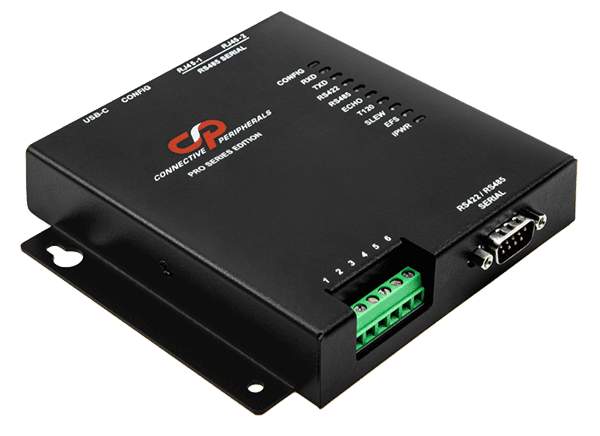- support@husseinkey.com
- livechat
Connective Peripherals USBC-H-422/485-M PRO and USBC-H-422/485-M ISO PRO Serial Adapters provide a simple method of adapting legacy serial devices with RS422 or RS485 interfaces to modern USB ports. This is accomplished by incorporating the industry standard FTDI FT232H USB-Serial bridge chip that offers USB 2.0 Hi-Speed (480Mbits/s) and Full Speed (12Mbits/s) compatibility. The USBC-H-422/485-M devices allow users to configure the serial interface mode selection and operating settings entirely via a software utility tool instead of using DIP switches and jumpers.
Aside from the RS422 or RS485 mode, the devices feature four configurable selections based on the communication standard, including Termination (120Ω), Slew Rate (for enhanced distance/EMI emissions), Echo (RS485 interface mode only), and Extra-Fail-Safe mode (EFS, by enabling the bias resistors). These settings and data transmission traffic are visually confirmed by LED indication. It is possible to configure the serial port for data communication up to 3M baud rate with Slew Rate set to OFF.
For USBC-H-422/485-M ISO PRO (only), the serial adapter is for applications where the devices must be placed in a different building or in the same building but using a different power supply system. This protects the devices from large lightning spikes/electric shocks and suppresses any harmful electric noise.
Flexible mounting allows the USBC-H-422/485-M PRO or USBC-H-422/485-M ISO PRO to be used in various applications, from a portable adapter to accompany a laptop to permanent installations in industrial, commercial, and retail locations. Mounted inside a metal enclosure, the electronic circuit boards provide improved isolation performance and robust ESD protection.
The Connective Peripherals USBC-H-422/485-M PRO and USBC-H-422/485-M ISO PRO Serial Adapters require USB device drivers, available free from https://connectiveperipherals.com/pages/resources. The USB device drivers allow the USBC-H-422/485-M PRO or -ISO PRO to appear as a Virtual COM Port (VCP), allowing existing serial communications software, such as Tera Term, to exchange data through the serial adapter to a legacy RS422/RS485 peripheral device.










